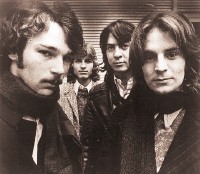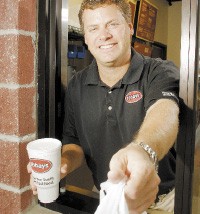For many music afficionados, Memphis’ Madison Avenue is the Southern equivalent of Abbey Road. Yet thousands cruise past the low-slung brick building at 2000 Madison wholly unaware of the impact the address has had on popular culture. Disguised as a credit union, or, as one record producer jokes, “a rest home,” Ardent Studios has unequivocally changed the course of American music.
This month, Ardent is celebrating its 40th anniversary — four decades of recording such artists as the Staple Singers, Al Green, the Bar-Kays, ZZ Top, the Fabulous Thunderbirds, the Allman Brothers, B.B. King, Robert Cray, the North Mississippi Allstars, Travis Tritt, Waylon Jennings, Marty Stuart, Primal Scream, the Afghan Whigs, R.E.M., Three 6 Mafia, 8Ball & MJG, and Yo Gotti. Led Zeppelin mixed III at Ardent, and James Taylor crafted Mud Slide Slim behind these doors.
Iconic artists such as Bob Dylan, Joe Cocker, and Stevie Ray Vaughan have used Ardent’s facilities, while an incredible roster of million-sellers and Grammy-winning hits — Steve Earle’s Copperhead Road, the Gin Blossoms’ New Miserable Experience, 3 Doors Down’s The Better Life, and the White Stripes’ Get Behind Me Satan — and masterpieces — Big Star’s Third, ZZ Top’s Eliminator, the Replacements’ Pleased To Meet Me, the Vaughan Brothers’ Family Style, and Cat Power’s The Greatest — were either recorded or mixed in these hallowed halls.
Although owner John Fry launched Ardent in the late 1950s as a recording studio and label when he was still a student at Memphis University School, locating the facility in a renovated garage (his grandmother’s sewing room served as the control room) connected to his parents’ house in East Memphis, he dates the company’s official beginning to1966, when he relocated his fledgling operation to a commercial space at 1457 National Street.
The ’50s and ’60s were a heady time for Memphis music: Sun, Sam Phillips’ Recording Studio, Sonic, Stax, Hi, Sounds of Memphis, and American Studios were in full swing. Record stores such as Pop Tunes, Ruben Cherry’s Home of the Blues, and Stax’s Satellite Record Shop stocked the latest records while radio stations WDIA and WHBQ employed hip deejays such as Nat D. Williams and Dewey Phillips to spin the hottest rockabilly and R&B singles.
For teenagers like Fry and his fellow MUS classmates John King and future FedEx founder Fred Smith, it seemed like hit records were waiting to be snatched from thin air. The three experimented with radio broadcasting and film before releasing a single, “At the Rock House,” by a Florida-based group called Freddie Cadell & the Twirls. Soon, other musicians, including Jim Dickinson and Terry Manning, dropped in, and, impressed with Fry’s ability and his wealth of recording equipment, decided to make Ardent their home base.
John Fry: I’m not a musician. I can’t play an instrument and I only sing in church, but when I was growing up, my friends and I would do anything to hear a radio show from another part of the country. We’d make antennas, trying to tune in the Beatles’ invasion over WABC in New York. We even built a pirate radio station. Then I thought, in addition to playing records, it might be interesting to record them.
John King: [Fry] was always reading Popular Science and technical brochures from electronics manufacturers. He built a radio transmitter but the signal didn’t go very far. He and Fred Smith got into television, and they decided to get John’s grandma to put on a cooking show. Somebody’s foot got caught in a cord, and she was like, “Ack, ack,” almost choking. From the beginning, his parents were very supportive, helping make a fertile, creative place for left-of-center people.
Fry: You’d think most people would discourage their kids from getting into anything like this, but my parents just said, “You can do whatever you want, but whatever it is, try to be good at it.” We were actually recording 45s and putting them out as well as doing rentals and service recording. It was pretty disruptive. Bands were coming to their house all the time, and all my parents ever said was, “Who are all these people? Why do some of ’em have so much hair?”
Jim Dickinson: Fry had a wet bar and a three-phone office and better equipment than American. The studio was in a separate building, with a patio between it and the control room, so if you were engineering, you couldn’t see anything that was going on. One night, Jimmy Crosthwait was out there banging on a cardboard box with some maracas. Fry asked, “Is he smoking marijuana out there?” I said “yes,” and Fry said kinda dryly, “Well, I was just curious.” He acted like an old man when he was a teenager, but in his own way, he was incredibly hip. He always wore a coat and tie like the English producers, and black musicians would look at him and say, “Bwana bwana, we want white man magic!”
In 1966, when his parents sold their house, Fry found himself at a crossroads: Quit the recording business or move the studio. He was 21 years old when he signed the lease on a brand-new building on National Street in North Memphis, recruiting Manning and Dickinson to help him relocate. He purchased a control board built by WDIA broadcast engineer Welton Jetton, who crafted similar equipment for Stax Records. Soon, Stax chairman/producer Al Bell began utilizing Ardent as a second studio, sending acts such as the Staple Singers uptown to record.
Fry: We stepped up the equipment, going from two tracks to four. Welton showed up on the doorstep, which was really fortunate, because Stax only had one studio but they were making more and more records. They began to send us their overflow work, which was a remarkable break. We went from recording in the house to cutting hit material. John Pepper, who owned ‘DIA, also began sending us work cutting jingles and station I.D. packages, which exposed us to a variety of styles and instrumentation. I looked like I was about 16, and even then I wondered why they’d allow a bunch of kids to do this stuff.
Dickinson: Manning and I became engineers at the same moment — when Fry went home for dinner one night and didn’t return. There was a jingle session, and Manning and I wondered, “Are you gonna punch the red button or am I?” To Manning’s eternal credit, he suggested we both punch it.
Fry: Along with the jingles and Stax work, we were trying to record our own artists. The Batman TV show was starting, and they were running promos for it on WHBQ. Jim Dickinson conjured up a girl group called the Robins. We bought an old car and had a metal shop put fins on it and turn it into a Batmobile.
Mary Lindsay Dickinson: It was plain to me that if I ever wanted to see my husband, I had to work alongside him. So when Jim had the idea to cut a song for a girl group, I put my hand up. Our first gig was at Catholic High School. I was timid about getting onstage, but wearing a black velvet costume and a mask, I got over it. John, who was always a voice of sanity in a very insane situation, would escort us to our gigs in a remodeled black Buick, which had wings, spotlights, and toy machine guns that spit sparks.
Al Bell: One of the Bar-Kays told me about Ardent, and in ’68, after Stax separated from Atlantic Records, I went to check it out. The marketplace was saying that Stax was dead — Otis [Redding] was killed in the plane crash — and we woke up to find out that our biggest hitmakers, Sam & Dave, were signed to Atlantic. We lost our back catalog to Atlantic, too, so we had nothing. I found a track on Booker T & the MGs, and I took it to Terry Manning and said, “This feels like a hit to me.” Manning played marimbas on it, and the song became “Soul Limbo,” one of the records that aided in the resurrection of Stax. After taking the Staple Singers to Muscle Shoals to cut basic rhythm tracks, we came to Ardent, where Manning helped me capture the vocal sound I wanted on songs like “I’ll Take You There” and “Respect Yourself.” We built the foundation in Muscle Shoals then we went to Ardent, where we baked the cake.
At Stax, we had to take the technology we had — which a lot of people laughed at — and make it work. Fry set up Ardent by the book. Something about the physical environment there gave rise to a kind of closeness that we didn’t have at Stax. Ardent was more intimate, and I felt at home there. I’m not a musician, but I can hear and I can feel. I had a problem at Stax walking into the studio with great musicians like Booker T & the MGs, who literally intimidated me. I had to find someplace where they looked at me as Al Bell, not as someone who couldn’t play.
The album that topped it all for me at Ardent was [Isaac Hayes’] Hot Buttered Soul. I had the idea to take this long song [“Hyperbolicsyllabicsesquedalymistic”] and turn it into a musical about the pimp and the preacher, with Isaac rapping and doing his thing. We had three other songs, and with this, we had enough for an album. I told Fry, “Let the tape run, man, until we get all we can out of this.”
Fry: Those songs were long! I’d have to actually walk out onto the studio floor while the band was playing and make a motion with my hand so that Isaac knew to either figure out how to end the song or let us start another reel.
By the early 1970s, Ardent had entered a co-venture with Stax, scouting and recording rock bands for the soul label, which in turn lent its mastering facility, run by Larry Nix, to Fry. An album by Oklahoma-based rockers Cargoe was followed by an auspicious debut: #1 Record, released by Big Star, a brand-new, Beatles-esque group formed by Alex Chilton, Chris Bell, Andy Hummel, and Jody Stephens. While the band was in the midst of recording, Ardent used Thanksgiving weekend in ’72 to move again, to a brand-new facility — still its headquarters — on Madison Avenue. Eighteen months later, John King staged the Rock Writers’ Convention, funded by Stax, which brought critics such as Lester Bangs and Nick Tosches to Memphis to see Big Star perform.
Fry: It just so happened that across National, there was a Big Star grocery store. In ’71, a little band was looking for a name. They looked across the street, and thought, what about that? But if you’d told me back then that people would be talking about Big Star 35 years later and that they’d have their music on a popular TV show (“In the Street,” off #1 Record, was the theme song for That ’70s Show), I’d have said you’re crazy. I was in the middle of something special, yet at the time, I didn’t realize it.
Jody Stephens: I was a senior in high school, and I was astonished because Chris and Andy had keys to Ardent. In the beginning, we’d go in under the cover of night, when Fry, who I perceived as an adult, wasn’t there. Once we began working together, I was intimidated by his dead seriousness. Ardent existed because of him. He was the provider, the reason we were able to be creative. Alex and Chris had a vision, which we were able to pursue without reins or over-the-shoulder guidance. Maybe we could’ve done the same thing at another studio, but Fry’s behind-the-board skills were sonically unique. He made Big Star sparkle.
Larry Nix: Fry would bring in Big Star’s albums for mastering, and he’d sit on a stool in front of the high frequency limiters and crank them up to keep from breaking a circuit in the process. He wanted to get as much high-end as he could, and I thought he was crazy! But Big Star’s sound wasn’t like anything else, mostly because Fry was so far ahead of his time.
 Courtesy Ardent Studios
Courtesy Ardent Studios
(From left) John Fry, Jody Stephens, John Hampton and Jim Dickinson
Bell: I considered Fry, Dickinson, and Manning to be unique creative geniuses. I had tremendous respect for them, and I felt the same way about them that I did about Steve Cropper and Jim Stewart. They needed someone who saw their vision and could turn them loose, and I had a sense of the artistry they were seeing. I wanted to help with what assets we had, the way they’d helped us with “Soul Limbo.” I thought, these guys could do for rock what we did for soul. But by the time we got the Big Star records out, my attention was focused on saving my life and defending myself against multiple business and personal assaults.
Creditors forced Stax into bankruptcy in 1975, shortly after Big Star released its second album, Radio City. Ardent absorbed many of Stax’s engineers, including William Brown, Robert Jackson, Henry Bush, and Ron Capone. Even as the city’s music industry struggled to stay afloat, a loose amalgamation of Big Star musicians, led by Chilton and Dickinson, began work on Third, a provocative train-wreck of an album that would leave an indelible impression on its listeners. Even today, Third epitomizes the dichotomies and undercurrents at work at Ardent — Fry’s flawless craftsmanship, countered by his cohorts’ self-destructive tendencies, underscored by the situation with Stax. It was all captured in glorious stereo sound.
Fry: Stax’s closure was a huge shock. It affected everybody in Memphis. So many vendors and suppliers and employees depended on them. It was a terrible time, but fortunately, we survived. They accused Al Bell of fraud, and I went and testified as a character witness. We used to be in the record business together and now we’re sitting in a federal courtroom.
Bell: If Stax had been able to survive its economic assassination, then Ardent would be one of the world’s legendary rock labels. I think they would’ve been awesome, and I really regret that.
 Courtesy Ardent Studios
Courtesy Ardent Studios
Big Star
Fry: The immediate aftermath of Stax was depressing enough, then Dickinson and Chilton started working on Third. Chilton was having issues, and the record was made under difficult circumstances. The thing that got my goat most was one day when they had some homeless guy in the studio, staggering around, about three sheets to the wind. They had headphones on him, overdubbing something. I said, “If this is what we’re gonna be recording, don’t ask me to do it. Tell me when you’re done, and I’ll mix it.”
Stephens: I hung in there just to get a little more studio experience. There were some pretty dark moments that are still hard for me to process, but in retrospect, the sessions are an amazing record of what was going down in Chilton’s life at the time.
Dickinson: The crazier it was, the more I tried to do it. Possibly we didn’t go far enough. I never did get to finish. Slim, the homeless guy, really upset Fry, but he was having a fine time.
The decade began its strange, sad closure in ’78. Stephens went to Europe, where he discovered that Big Star had achieved cult status. That same year, Chris Bell was killed in a car wreck. Manning left to open his own facility, Studio Six. Back at Ardent, Chilton assembled a new set of session musicians, including drummer Ross Johnson, to cut a solo record, Like Flies On Sherbert, and produced the Cramps’ Songs the Lord Taught Us with Ardent’s newest engineer, John Hampton. And Fry, who began reading the Bible with Bell’s encouragement, found God.
Stephens: In London, I ran into Nick Kent, who had a copy of Third, which hadn’t been released yet. I found a picture of Alex in Melody Maker, and in another magazine, I saw an advertisement for someone looking for Big Star records. It really reinforced how far we’d reached.
 Courtesy Ardent Studios
Courtesy Ardent Studios
The Raconteurs with (far right) John Hampton
Fry: Chris was killed on December 27th, 1978, and his funeral was on December 28th. Sometime before December 31st — my birthday — I went from having “head knowledge” about God to trusting Jesus. In ’79, (contemporary Christian musicians) DeGarmo and Key showed up and wanted to record. With their label, Forefront, we made a deal like Stax, where we provided A&R and production and they provided promotions and distribution.
Ross Johnson: We started Like Flies on Sherbert at Sam Phillips’ in February 1978, and finished sessions at Ardent the next August. We’d begin around noon, after I’d already had my liquid breakfast, and I’d be knocking over mics, doing drum overdubs when Hampton would say, “Come lie down on the couch.” No matter what alcohol-fueled fun was going on around him, Chilton always knew what he wanted to go on tape. He liked to do music in a social context, with people coming in and out of the studio, but he never got lost, even when people were spilling drinks on the board or having hissy fits.
John Hampton: Songs the Lord Taught Us was the first session I actually engineered. Working with Chilton and the Cramps was simply a blast, the kind of session where anything goes. I finally figured out what it was — performance art from New York that got famous as a band. They wanted me to record a crash, so we piled up folding chairs and pieces of glass, set up 100 mics, and threw cinder blocks on it. At Ardent, they produced and engineered at the same time — coming up with vocal parts or guitar lines, stuff they would’ve gotten fired for if they were working in L.A.
 Courtesy Ardent Studios
Courtesy Ardent Studios
Cat Power, Stuart Sykes, and Adam Hill
In the ’80s, Ardent hit its stride, cutting ZZ Tops’ Eliminator, which sold 10 million copies, and launching another A&R venture with Stephens, who landed deals for local talent such as John Kilzer and Tora Tora. By the late ’90s, talented tech heads Jeff Powell (who met his wife, Susan Marshall, in Studio A), Pete Matthews, and Jason Latshaw had joined the fold, working as engineers before graduating to producer status.
Larry Nix’s son Kevin began assisting with the mastering process, while second-generation musicians Luther and Cody Dickinson and Steve Selvidge, son of one-time Ardent artist Sid Selvidge, began doing session work. The company’s cult status parlayed into further successes, as R.E.M., Primal Scream, the Gin Blossoms, the Afghan Whigs, and Mudhoney recorded at Ardent. The Replacements, who would cut a song called “Alex Chilton,” recorded Pleased To Meet Me with Dickinson, who had turned his Big Star tenure into creative cachet.
Hampton: ZZ Top came here to bathe in the water. They wanted to get away from home, and they believed in the musical vibe that’s in the air here. Same with the Vaughans: When Stevie Ray and Jimmie weren’t working, they were down on Beale Street listening to local bands.
Dickinson: When the Replacements came here, they were looking for a place to break up. Then it started to work, and I realized it was gonna be a good record, even as the lore about the sessions overshadowed what really happened.
Hampton: [Replacements frontman] Paul Westerberg had a jug of Gallo wine that he pitched into a garbage can. It spit out a plume of red wine on the wall, and that turned into, “That’s where Paul barfed,” which turned into “they were barfing into their hands and throwing it on the wall.”
Although Fry no longer engineers sessions, he capably runs his company, effortlessly bridging the gap between the contemporary-Christian market and Memphis’ latest export, gangsta rap. It’s not uncommon to have Todd Agnew holed up in one studio, with Yo Gotti or Three 6 Mafia working next door, or superstars like Bob Dylan or Jack White dropping by to record or mix. At press time, Ardent has its hands in two current hit records, the Raconteurs’ Broken Boy Soldiers, which was mixed by Hampton, and Skillet’s Christian rock album, Comatose, which sold some 18,000 copies last week.
Fry: I tell people I’ve had the same job for 40 years, but the job description changes about every five minutes. That’s fine — I don’t get bored that way. Since launching the Christian label, we’ve made 36 albums on artists like Todd Agnew, whose debut record Grace Like Rain sold close to 300,000 copies, while his first single (also titled “Grace Like Rain”) sold 1.5 million.
Todd Agnew: I was an independent artist for 13 years, and I had no intention of signing with Ardent. If I hadn’t, I’d still be out there, playing a few weekends a month, doing youth-group shows for pizza and gas money. I’m pretty skeptical of the music industry, so I don’t think I could’ve signed with anybody else. Here I found good people I could trust and a place that’s making great music. I’m a Texas boy, and knowing that Stevie Ray and ZZ Top recorded here moved my heart a little bit!
Hampton: Ardent has somewhat of a sordid reputation, so (the Christian influx) has been a positive thing. They help give this place a good vibe. On the other hand, Jack White told me part of the reason he initially came here was because I’d done the Cramps. He’s returned because we treat him like one of the guys, which he really is. Keeping up with kids making records in their bedrooms can be pretty tough. Not only have we lasted, we’ve lasted 40 years.
Dickinson: That Ardent sound has come a long way from Granny’s sewing room. Any musical tradition this city has now would’ve dried up and blown away after Stax went out of business if it hadn’t been for John Fry. Anybody creating music in Memphis today is doing it because of him.
 Courtesy Ardent Studios
Courtesy Ardent Studios  Courtesy Ardent Studios
Courtesy Ardent Studios  Courtesy Ardent Studios
Courtesy Ardent Studios  Courtesy Ardent Studios
Courtesy Ardent Studios  Justin Fox Burks
Justin Fox Burks